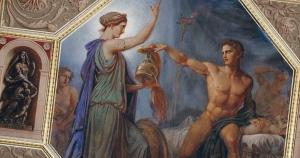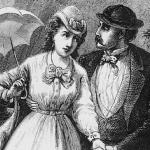I asked for new voices and got some outstanding writers! Today we hear from the erudite James R. Harrington.
 James R. Harrington earned his M.A. in Ancient History at California State University Fulleron and is a member of the Torrey Honors Institute. James has been a classical educator in a variety of settings over the past thirteen years. He lives in Houston with his wife, Sharon, and their daughter.
James R. Harrington earned his M.A. in Ancient History at California State University Fulleron and is a member of the Torrey Honors Institute. James has been a classical educator in a variety of settings over the past thirteen years. He lives in Houston with his wife, Sharon, and their daughter.
Harrington began with a series on shields in classical literature and now moves to witches as a theme.
On shields, Mr. Harrington responded to thoughts on his first post. Harrington wrote about the shield of Herakles, He continued to the shield of Aeneas and followed up on that post. We turned to a shield in Ovid. He concluded with Quintus and a follow up.
Now he turns to witches with a second post:
In our last post, we examined the close link between medicine and magic evinced by Homer’s healers in the Iliad. This week, we turn to another Homeric adept in the art of pharmaka, one step closer to the ideal European “witch” Judge Hathorne had in mind at Salem: Helen of Troy.
By 1692, Helen of Troy’s name had already entered the pop-canon of European witch-lore with Christopher Marlowe’s play Faust.* Marlowe specifically plays on the idea of Helen’s irresistible sexuality as a temptation of the Devil. While Homer knew nothing of the Devil, he does portray Helen’s beauty as supernaturally baleful. The Trojans are so enraptured by her that they refuse to release her, against the advice of the elders, even though it spells doom for their city. These elders see Helen clearly:
Small blame that Trojans and well-greaved Achaeans should for such a woman long
suffer woes; she is dreadfully like immortal goddesses to look on. But even so, though
she is like them, let her go home on the ships, and not be left here to be a bane to us and
to our children after us.**
Helen is thus the prototype in European literature of the fey enchantress, the woman who brings about destruction by her supernatural beauty. However, Helen’s beauty does not come about because of sorcery or pharmaka, but is due rather to her status as a daughter of Zeus; she cannot help being what she is.*** The harm she causes is not intentional.
Helen is a very intentional user of pharmaka, however, particularly those that grow in Homer’s magic-saturated land of Egypt.° As with the Iliad’s “combat medics,” the use of these pharmaka is benevolent: they cure pain. We see an example of this when Odysseus’ son, Telemachus, comes to question Helen and Menelaus regarding his father’s disappearance. As the young prince and the old war hero talk, neither can refrain from weeping. Ever the good hostess, Helen turns to her pharmaka:
Then Helen, daughter of Zeus, took other counsel. At once she cast into the wine of
which they were drinking a drug to quiet all pain and strife, and bring forgetfulness of every ill.… Such cunning drugs had the daughter of Zeus, drugs of healing, which Polydamna, the wife of Thon, had given her, a woman of Egypt, for there the earth, the giver of grain, bears greatest store of drugs … there every man is a physician, wise above human kind…°°
While there is scholarly debate over whether Helen is wise to use her pharmakon and whether its effect is entirely beneficial in this particular situation, it seems clear that Helen’s motive is to show hospitality by assuaging her guests’ grief.°°° She is not a wicked witch poisoning the princes, but an attentive hostess using all her resources in the important custom of xenia, or ritual hospitality.
Helen’s motives are the key to setting her apart from the witches of later European folklore. As theologian and occultist Charles Williams points out, the ideas that make a “witch” into a “Witch” are the use of magical power for harm and hatred/jealousy of the One God.§ Nonetheless, in her supernatural capacity for destruction, Helen has been persistently associated with the occult forces of evil.§§ While Helen of Troy may remain ambiguous, our next post turns to a more malevolent figure: the enchanting goddess, mixer of baleful drugs, wand-wielder, and necromancer, Circe.
—————————————————
*Bettany Hughes, Helen of Troy: Goddess, Princess, Whore. London: Pimlaco, 2006. pp. 298-307.
**Homer, Iliad. A.T. Murray trans. Cambridge: Harvard University Press, 1999. pp. 140-141. Translating for lines III.156-160.
***Suzanne Saïd, Homer and the Odyssey. Oxford: Oxford University Press, 2011. p. 273.
°François Hartog, Memories of Odysseus. Janet Loyd trans. Chicago: Chicago University Press, 2001. pp.47-48.
°°Homer, Odyssey. A.T. Murray trans. Cambridge: Harvard University Press, 1998. p. 135. Translating for lines IV.219-232.
°°°Saïd, 271-272.
§Charles Williams, Witchcraft. Berkley: Apocryphile Press, 2005. pp. 32, 38-39.
§§As early as the second century A.D. in Gnostic literature and the Simon Magus romance: Ibid., pp. 31-33. see also Hughes, 281-288.











